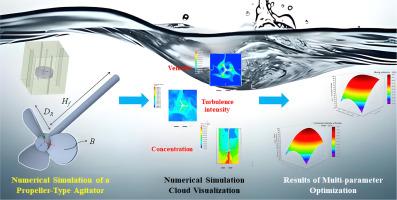基于流场分析的推进搅拌器结构参数优化设计
IF 3.9
3区 工程技术
Q3 ENERGY & FUELS
Chemical Engineering and Processing - Process Intensification
Pub Date : 2025-07-24
DOI:10.1016/j.cep.2025.110467
引用次数: 0
摘要
螺旋桨式搅拌器在工业生产中有着广泛的应用。然而,对其结构参数优化和流场性能的研究却很少。本文建立了实际工程应用中螺旋桨式搅拌器的物理模型,并通过物理实验验证了模型的准确性。对无量纲结构参数进行优化,利用均匀性指数和混合均匀性等评价指标定量表征湍流强度分布和混合效果。采用计算流体力学(CFD)和响应面法(RSM)相结合的方法对结构参数进行优化。优化目标集中在叶轮叶片曲率、直径和安装高度上,以达到最佳的混合性能。结果表明,适当的安装高度Hf = 0.335可在不增加功率消耗的情况下提高混合效率。叶片曲率呈现非单调优化特征,最优曲率B = 0.908。当叶片曲率B = 0.908,直径比DR = 1.713,安装高度Hf = 0.335时,获得了最佳配置,提高了混合性能。本研究结果为流体混合机械的优化设计奠定了理论基础,并为工业混合过程的设计和操作改进提供了可操作的指导方针。本文章由计算机程序翻译,如有差异,请以英文原文为准。

Flow field analysis-informed optimisation of structural parameters in propulsion agitator design
Propeller-type agitators have broad applications in industrial production. However, there has been limited research on their structural parameter optimisation and flow field performance. In this study, a physical model is established for a propeller-type agitator in practical engineering applications, and its accuracy is validated through physical experiments. The dimensionless structural parameters are optimised to quantitatively characterise the turbulence intensity distribution and mixing effectiveness using evaluation metrics, including the uniformity index and mixing uniformity. Optimisation of the structural parameters is performed using a combined approach integrating computational fluid dynamics (CFD) with the response surface methodology (RSM). The optimisation objectives focus on the impeller blade curvature, diameter, and installation height from the bottom of the tank to achieve optimal mixing performance. The results demonstrate that an appropriate installation height of Hf = 0.335 improves the mixing efficiency without increasing the power consumption. The blade curvature exhibits non-monotonic optimisation characteristics, with an optimal curvature B = 0.908. The optimal configuration is achieved with a blade curvature B = 0.908, diameter ratio DR = 1.713, and installation height Hf = 0.335, which provide an enhanced mixing performance. The findings of this study establish a theoretical foundation for optimising the design of fluid mixing machinery and provide actionable guidelines for the design and operational refinement of industrial mixing processes.
求助全文
通过发布文献求助,成功后即可免费获取论文全文。
去求助
来源期刊
CiteScore
7.80
自引率
9.30%
发文量
408
审稿时长
49 days
期刊介绍:
Chemical Engineering and Processing: Process Intensification is intended for practicing researchers in industry and academia, working in the field of Process Engineering and related to the subject of Process Intensification.Articles published in the Journal demonstrate how novel discoveries, developments and theories in the field of Process Engineering and in particular Process Intensification may be used for analysis and design of innovative equipment and processing methods with substantially improved sustainability, efficiency and environmental performance.

 求助内容:
求助内容: 应助结果提醒方式:
应助结果提醒方式:


